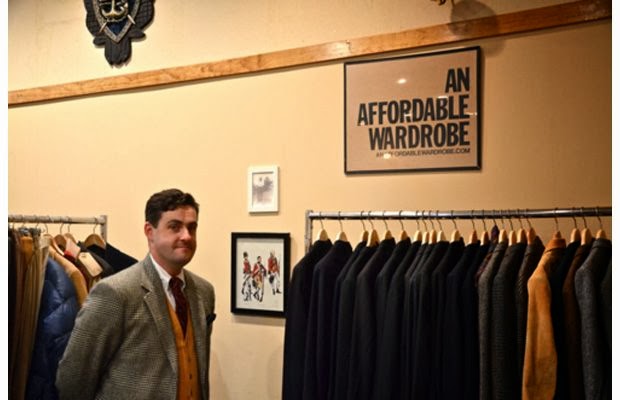Back in July, I managed to "score" the suit in the above photo from ebay. It's a custom made suit by Alan Flusser, circa mid-90s. I wrote about it shortly after receiving it, using it to illustrate my "Law of Averages" theory as it applies to thrift shopping. It's made of a heavy nailhead cloth, and it's been hanging at the back of the closet in the "on deck circle", awaiting it's trip to the tailor. Every time I take it out to bring it to be fitted, it winds up getting bumped for other pending alterations. The longer I wait, the more I contemplate whether it might not be time to cut my losses on this one.
A three piece double breasted suit, seldom seen since the 1930s, is certainly not an easy garment to come by. Simply having one is something of a second hand/cheapskate gold medal. But when will I wear it? Lord knows I don't really need it. Hell, I don't really need any of this stuff. And the cost of alterations? OK, that's it, my mind is made up....
And then Tin Tin (remember him?) posts this photo, from a mid-90s era Esquire article written by none other than Alan Flusser himself. And I see such a suit in action, and I know now that I must have it...but wait a minute, no, I don't. Perhaps you see my dilemma. Or perhaps you are a more well adjusted, level headed person who is only reading this bog and others like it to marvel at the amount of time and thought that some fellows put into something so ultimately superficial and inconsequential. In any case, I appeal to you for help.
On September 19, 2008, the fellow formerly known as "Longwing" (remember him?) commented in response to this blog's very first post:
"Thrifters have too much shit. You get used to not getting exactly what you want so you tend to buy everything that even comes close."
I refuted him then, even though I couldn't help but admit that he indeed had a very valid point. It's a mild form of hoarding sickness that I have fought hard to keep in check all my life. I feel that I do fairly well, and no doubt operating a second hand clothing business does give me a convenient outlet for unwanted or no longer needed garments. But I ask you, is this not just the sort of situation old Longwing was talking about? Do I bite the bullet and pour more cash into making this suit fit? Or do I recoup my investment and get this thing into the hands of someone an inch or so taller than me? After all, I have a pair of cream colored flannel trousers already at the tailor's awaiting pick up, and a pair of cavalry twills to be dropped off, to say nothing of the dry cleaning.
Torture and anguish, thy name is a less than perfect ebay score. Thoughts and opinions greatly appreciated.







.JPG)












